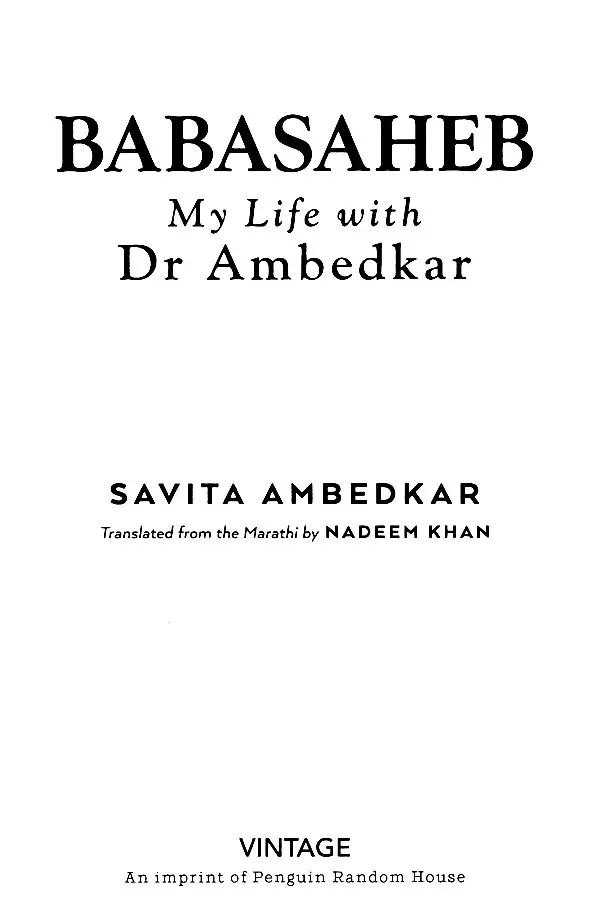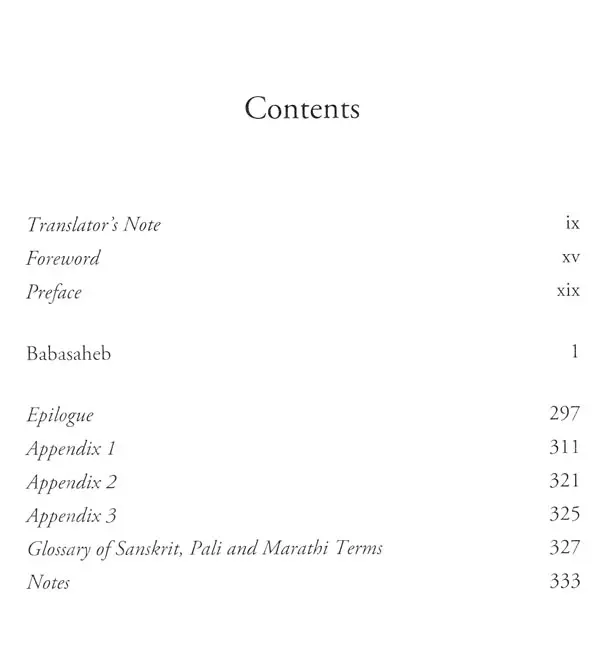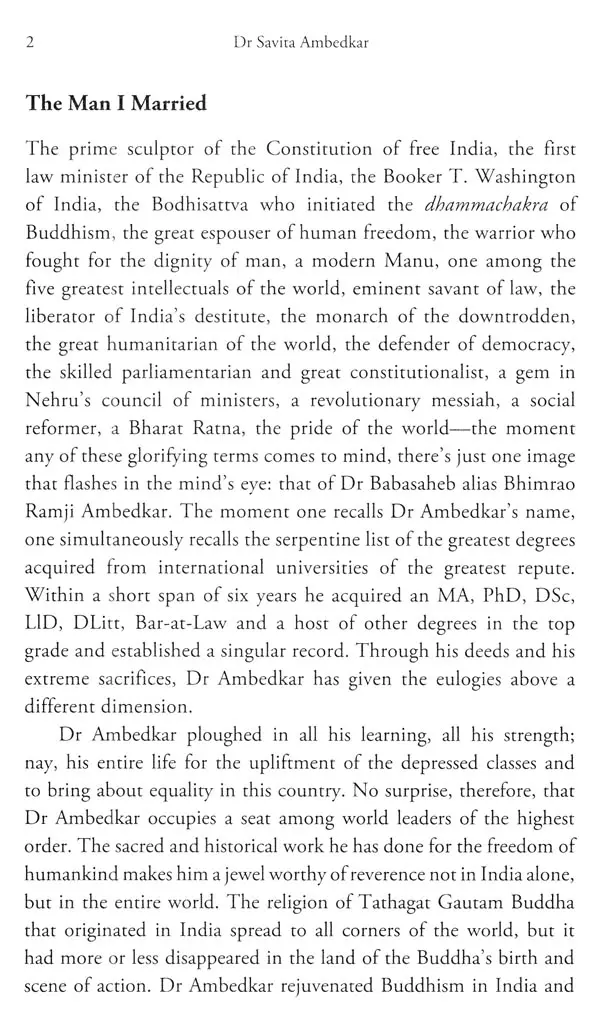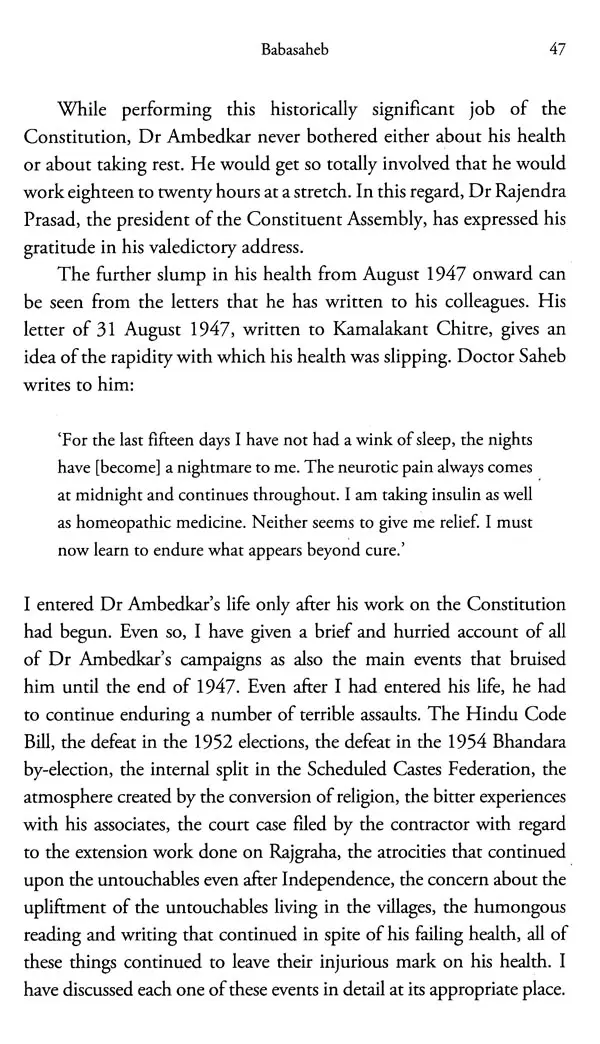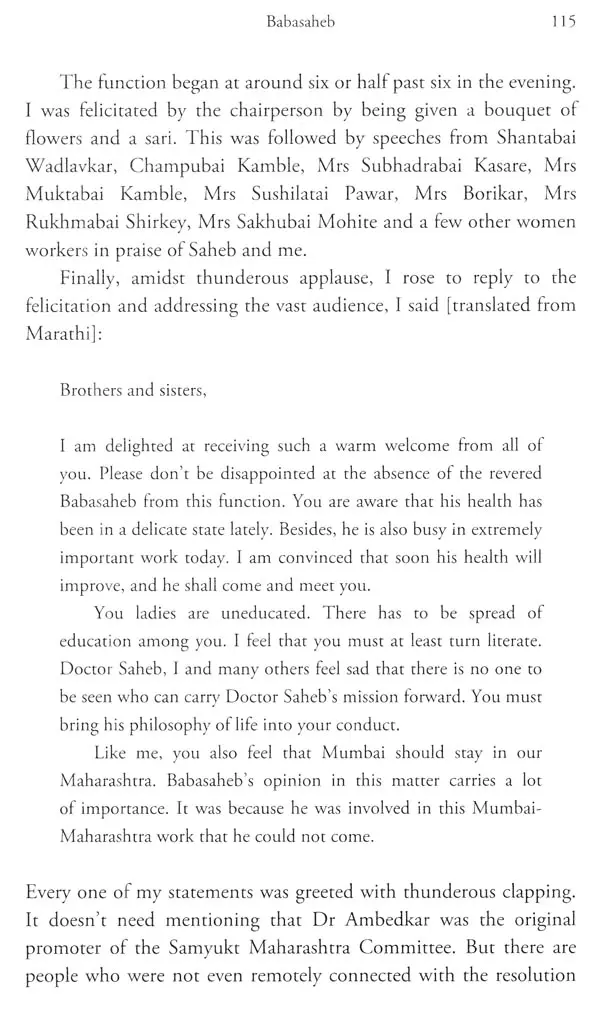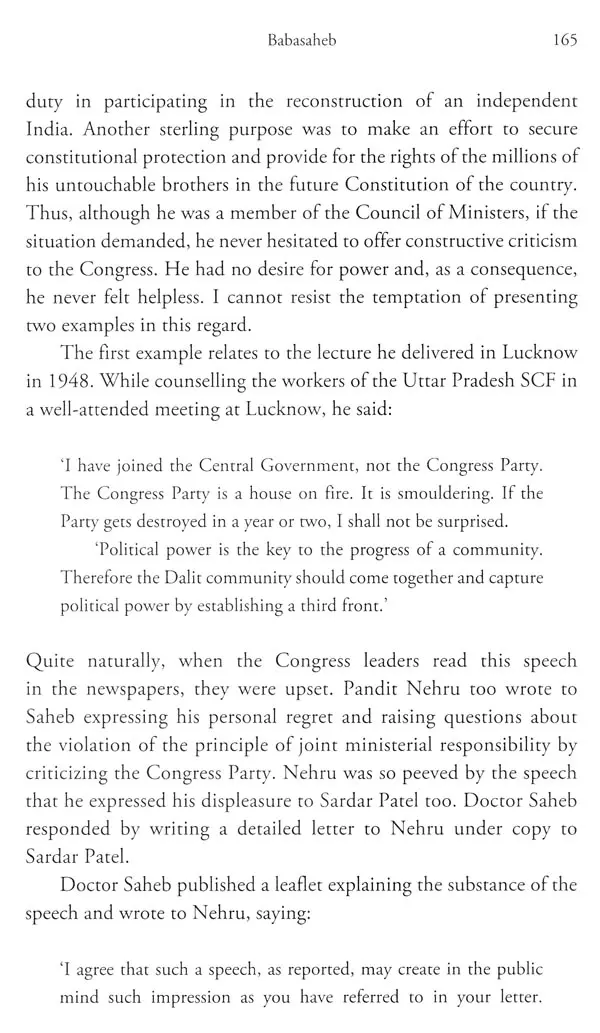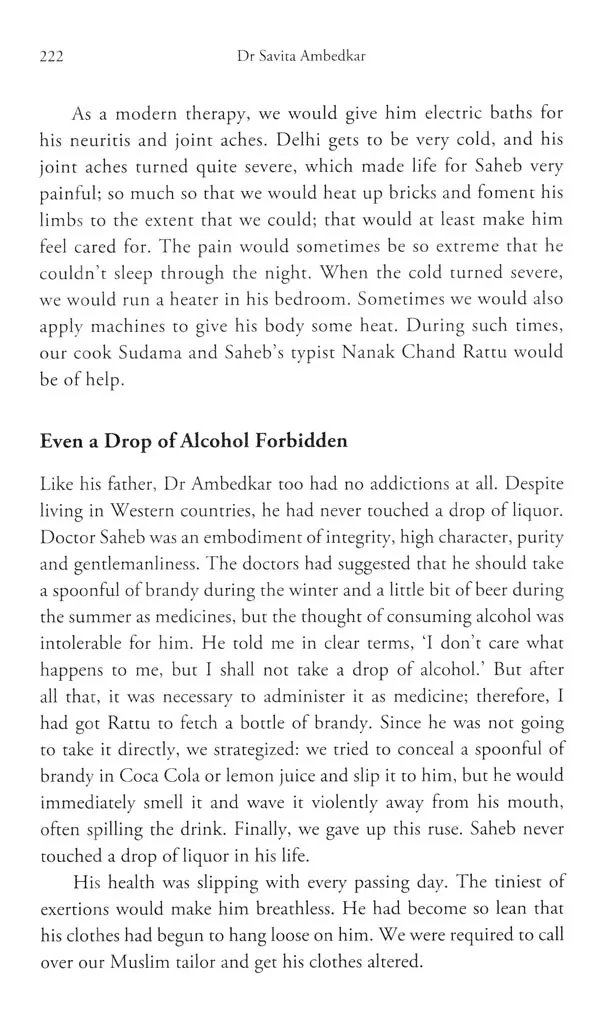
Babasaheb: My Life With Dr Ambedkar
Book Specification
| Item Code: | UBD623 |
| Author: | Savita Ambedkar |
| Publisher: | Penguin Random House India Pvt. Ltd. |
| Language: | English |
| Edition: | 2022 |
| ISBN: | 9780670096695 |
| Pages: | 362 (Throughout Color and B/w Illustrations) |
| Cover: | HARDCOVER |
| Other Details | 9.00 X 5.50 inch |
| Weight | 510 gm |
Book Description
Born into a middle-class, Sarasvat Brahmin family, Dr Sharada Kabir met and got to know Dr Bhimrao Ambedkar as a patient riddled with life-threatening diseases, and eventually married him on 15 April 1948, getting rechristened as Savita Ambedkar. From the day of their wedding to the death of Dr Ambedkar on 6 December 1956, she aided him in some of his greatest achievements-drafting the Constitution of India, framing the Hindu Code Bill, writing some of his most celebrated books, including The Buddha and His Dhamma, and leading millions of Dalits into Buddhism. Following his death, she was hounded into obscurity by some of Dr Ambedkar’s followers, who saw her as a threat to their political ambitions. She re-emerged into public life in 1970 and got back to working on the mission to which her husband had devoted his life-the welfare of the Dalit community. Her autobiography, Dr Ambedkaraanchya Sahavaasaat, was first published in Marathi in 1990.
This English translation by Nadeem Khan unearths a much valuable and forgotten account, an intimate portrait of one of the greatest figures of the twentieth century. A tenacious fighter, an outstanding scholar and an iconic leader, Dr B.R. Ambedkar was all that and more. Savita Ambedkar brings alive a different side of her husband: a man who wrote romantic letters, dictated what she should wear, whipped up delicious mutton curry, played the violin, and even tried his hand at sculpting. This is a book that humanizes Ambedkar as no other book has done yet.
NADEEM KHAN has been a teacher of English since 1973. He was the founder director of the Western Regional Centre of the Indian Institute of Mass Communication, an autonomous institute run by the Ministry of Information and Broadcasting, Government of India, from 2011 to 2018. He has translated well over a dozen books-mainly from Marathi into English-including Vishwas Patil's celebrated Marathi novel Panipat and Avadhoot Dongare's Sahitya Akademi Award- winning novel Swatahala Faltu Samajnyachi Gosht. He is the winner of the Valley of Words award for the best-translated book for the year 2020.
Dr Bhimrao Ambedkar is a magnificent dream of humanity that occurs once in many hundreds of years. It is said that the touch of a philosopher's stone turns iron into gold. That was what happened when I became Mrs Ambedkar-I came into contact with the philosopher's stone named Dr Ambedkar and my life turned into gold. In the latter half of his life, I gave company to this great, epoch- making man like his shadow till the time he passed away. I made body, speech and heart one and served him, worshipped him. My life got permanently bound to this great, epoch-defining man who was the glory of the world. Can a life be more fulfilling than this?
It has rightly been said that behind the success of every great man lies the contribution of his wife. Ramabai in the earlier half and I in the second half stand as evidence of this aphorism.
Being a great man's wife is an ordeal, and this I have learnt from personal experience. Others may not understand the kind of circumstances that a great man's wife has to confront by being told about them. Add to that the fact that our circumstances were so unusually different! I belonged to the so-called sanarna class, the upper caste, and Dr Ambedkar belonged to the mahar community that was counted among the att-shudra, the untouchables, by the Hindu religious institution. Since we came from extremely different strata of society, our social and domestic circumstances were extremely different too.
The fact that Bhimrao Ambedkar is absolutely singular as a thinker does not negate the claim that he did not stand alone. He could not have scaled the heights he reached without the assistance of many others. Some of these supporting characters arrived through luck and fortune-K. A. Keluskar meeting a lonely young Bhim during his school days and introducing him to Sayajirao Gaikwad, or the brash young student in New York stumbling into John Dewey's classes as a respite from his heavy schedule of economics courses at Columbia University and initiating his lifelong interest in pragmatist philosophy. There is also the incredible, and often unnoticed, role that Bhimrao's first wife, Ramabai, played in facilitating his extended. journeys to the West for his education, and in pushing forward his anti-caste activism back in India. So many individuals played important roles in Bhimrao's life and thought, and each deserves to be preserved and explored in the stories we tell about the anti-caste thinker. This volume tells the part of Babasaheb's story witnessed and affected by Bhimrao's devoted second wife, Savita Ambedkar. 'Maisaheb', as Babasaheb's companion was known, is one of the most important observers of Ambedkar's final years, the period that saw him complete his turn toward Buddhism and his reconstruction of the Buddha's legacy and doctrine. This was the period of increasingly frail health for Bhimrao, but it was also a time when his activities and speeches proselytizing for Buddhism as a social gospel reached their most feverish pitch. Savita's part in this grand tale of Bhimrao's life emerges from her story, a role that history often denied her while Bhimrao himself waged his wars against caste and injustice.
Of course, Savita was not without an agency or initiative of her own. As one reads through these recollections, one sees how active and assertive Savita was in her dealings with Bhimrao as well as in shielding him from many of the individuals who wanted something from Babasaheb. She was, in many ways, his protector and guardian. She thought and fought alongside him. But the traditions of the time kept her from taking a larger role in public affairs, and the habits of our times often leave her stories and contributions unnoticed. As this book reveals. Savita was thinking through Buddhism with her husband right as he was actively speaking for Dalit conversion to Buddhism. I had my own realization of this point standing next to Vijay Surwade on one of my first journeys to India in pursuit of Ambedkar's archives. As we thumbed through dusty journals from the 1950s, we often talked-or more aptly, I often listened raptly to his tales about Babasaheb's life. While looking at the handwritten notes about Buddhism in one slowly disintegrating journal. I pondered aloud about what Ambedkar-Bhimrao, I meant was working through. I noted that the writing style was a bit off, as it lacked Bhimrao's artful extensions of one letter's final stroke merging into the next letter. Perhaps he was rushed. I ruminated. Surwade quickly set me straight, telling me that these notebooks on Buddhism and psychology were written by Savita, and not Bhimrao. It then struck me: as original as Bhimrao was, others were also thinking along with him or alongside him. Savita, the other Dr Ambedkar, was a medical professional who was also intensely interested in Buddhism. As Dr Bhimrao Ambedkar was deepening his vision of Buddhism, Dr Savita Ambedkar was also reading and thinking about what Buddhism could mean for society and for the removal of injustice.
Book's Contents and Sample Pages
